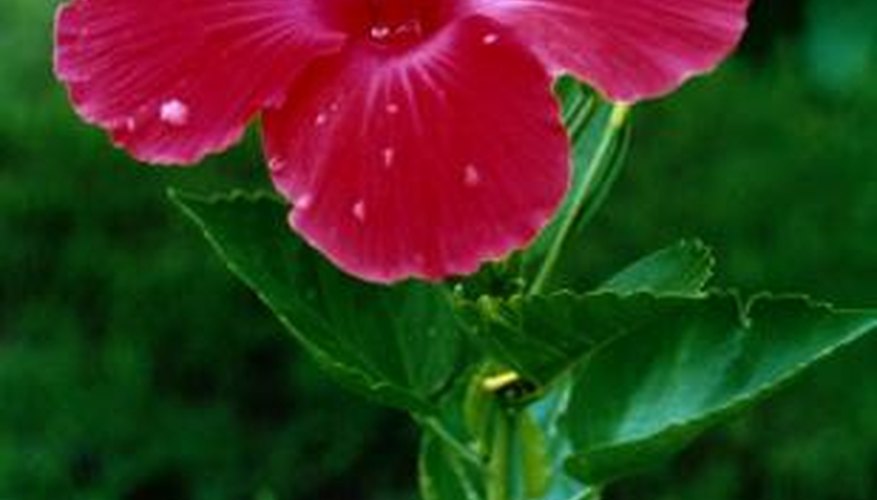Hibiscus, a member of the mallow family, includes a variety of plants grown for their flowers, and also as vegetable and fibre plants. Hibiscus is an angiosperm, or flowering plant. Angiosperms evolved along two main paths, as either monocotyledons or dicotyledons. Cotyledons are seed leaves that provide nutrients to embryo plants until seedlings have true leaves and begin photosynthesis. Monocotyledons, or monocots, have one seed leaf; dicotyledons, or dicots, have two.
Dicots
Hibiscus is a dicot. Dicots include a wide range of flowering plants, such as magnolias, water lilies, peach trees, beans and walnuts. Along with having two seed leaves, six other characteristics distinguish them from monocots. Dicots have broad leaves, with veins that branch out from a larger, central vein. Dicot vascular bundles--networks of tissues that transport water and nutrients throughout plants--form a ring around the inside edge of the plant's stem. Dicot flower parts, such as petals and stamens, are produced in multiples of fours and fives. Dicots have one main tap root. Dicot pollen has three pores or furrows. Dicots also have secondary growth, also known as wood. Most hibiscus varieties have woody stems.
- Dicots include a wide range of flowering plants, such as magnolias, water lilies, peach trees, beans and walnuts.
- Dicot flower parts, such as petals and stamens, are produced in multiples of fours and fives.
Monocots
Monocots are composed of grasses, including grains such as wheat and corn, along with garlic, lilies, hyacinths and orchids. Monocot leaves are usually long and straplike, with veins running parallel the length of the leaf. Monocot vascular tissue bundles are scattered randomly throughout their stems. Monocots usually produce flower parts in multiples of three. They have many fibrous roots sprouting from nodes on the plant's stem. Monocot pollen grains usually have just one pore or furrow. These types of plants do not produce wood, although some have thickened stems that allow the plant to live as a tree form, such as palm trees.
- Monocots are composed of grasses, including grains such as wheat and corn, along with garlic, lilies, hyacinths and orchids.
- Monocots usually produce flower parts in multiples of three.
Divergence
Although scientists are uncertain why angiosperms divided into two groups, the evidence suggests that the divergence occurred soon after the appearance of angiosperms, more than 100 million years ago. The University of California Museum of Paleontology notes that Theophrastus, a philosopher who lived circa 370 B.C. and had strong interest in plants, is believed to have first recognised the differences between monocots and dicots. However, until the1600s, plant classification was based upon overall growth form, such as whether they were trees or vines.
- Although scientists are uncertain why angiosperms divided into two groups, the evidence suggests that the divergence occurred soon after the appearance of angiosperms, more than 100 million years ago.
- The University of California Museum of Paleontology notes that Theophrastus, a philosopher who lived circa 370 B.C.
- and had strong interest in plants, is believed to have first recognised the differences between monocots and dicots.
Hibiscus Qualities
Hibiscus is grown primarily for its strikingly large, beautiful flowers, which provide a tropical look to gardens. While perennial dwarf varieties grow 2 to 3 feet tall, many varieties grow to 8 feet or more. Starting plants from seed in early spring enables many hardy varieties to bloom the first year. Hibiscus needs a lot of sun and water for good growth and abundant blooming.
- Hibiscus is grown primarily for its strikingly large, beautiful flowers, which provide a tropical look to gardens.
- Hibiscus needs a lot of sun and water for good growth and abundant blooming.
